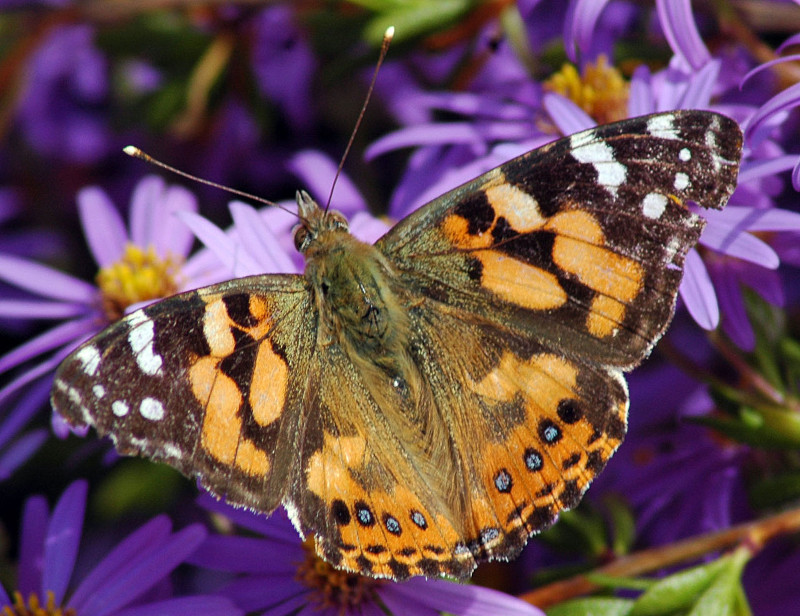
Australian Painted Lady Facts
- This gorgeous Lepidoptera is most frequently referred to by the obviously informative common name of the Australian Painted Lady. The beauty does have a few other general names, though. Those include such diverse terms as Cosmopolitan and Thistle Butterfly.
- Within scientific circles, however, it’s probably much known better by its purely technical title. Thankfully, that’s an extremely easy one for the layperson to pronounce. That’s because this marvel of Nature and evolution presently bears the official moniker of Vanessa kershawi.
- It received that specific name due to the efforts of the well respected Irish zoologist, Sir Frederick McCoy. The noted professional made the first formal acknowledgement of it as a separate and distinct species. That scientifically noteworthy event occurred in the year 1868.
- This gorgeous Lepidoptera often serves as a source of confusion and conflict among entomologists. That’s true since it’s very similar to a much more widely spread species. Many researchers believe it should be considered as only a subspecies of that better-known insect.
- The beautiful Australian Painted Lady appears to be maintaining a population base that’s both stable and sufficient. That pleasant also seems to hold true throughout the entirety of its range. The IUCN, therefore, presently has no listing for it on the Red List of Threatened Species.
- It nevertheless faces several possible threats to its continued existence as a species. In this, it follows the pattern of most species. The majority of these perils stem from the actions of humans. They include such dangers as habitat loss and the increasing effects of climate change.
Related Articles
Australian Painted Lady Physical Description
The visually stunning Australian Painted Lady is a wonder of Nature that understandably captures one’s interest easily. It does so primarily due to its appearance, though. That’s because, all other marvelous aspects aside, it ranks as an approximately average-sized butterfly species.
Interestingly, the Arthropod differs somewhat from many, though not all, related invertebrates. That’s true since it displays no easily noticeable degree of the physiological characteristic of sexual dimorphism. This results in it being extremely difficult for non-experts to distinguish the genders.
Individuals of both sexes attain an average wingspan measuring roughly 2 in (5 cm). This size actually makes it slightly smaller than the very similar species sharing the same range that leads to the previously mentioned issue. It’s among the main reasons some consider it to be separate.
The typically elongated body of this remarkable Lepidoptera generally shows entirely as an extremely dark brown, almost black. Uniquely, though, the tips of the long antennae display a bright white at the tip. Like many related creatures, that body possesses a covering of fine, soft hairs.
It’s without doubt the wings of the lovely Australian Painted Lady that garner the most appreciation, however. The background color consists of a brown shade. This, though, turns to a brick-red shade, crossed by black bands. Its forewings present as black, with four white dots and a white bar.
Meanwhile, the hindwings of the butterfly present four small round eyespots at the base. These also show a blue center for several. The underwings of the insect, though, display an almost identical pattern. However, the base of the underwings show a brick red color, instead of the brown.
- Kingdom: Animalia
- Phylum: Arthropoda
- Class: Insecta
- Order: Lepidoptera
- Family: Nymphalidae
- Genus: Vanessa
- Species: V. kershawi
Australian Painted Lady Distribution, Habitat, and Ecology
The startling beauty known as the Australian Painted Lady evolved as native to a somewhat limited section of the surface of our globe. That immediate setting likely won’t surprise anyone, given its name. That’s because, as that name implies, it’s mainly native to the continent of Australia.
Yet that’s not the sole location for this wonder of Nature. Perhaps riding the prevalent westerly winds of the region, it’s also present on several islands located in the area. Most prominently, that includes New Zealand. It’s not currently known if the insect ever appeared elsewhere.
This surprisingly impressive invertebrate helpfully evolved very generalized habitat requirements. Essentially, it appears anywhere in its range with the proper conditions. Primarily, this consists of the presence of relatively large quantities of plants with nectar producing blooms to feed on.
Intriguingly, in truly heavily populated areas, its zone of habitation often consists of backyard gardens and parks. This occurs due to the fragmentation of its natural feeding grounds by human urbanization. Away from such areas, however, it often frequents sites such as open meadows.
The magnificent Australian Painted Lady possesses an ecology very similar to its numerous related species. Often the same plant serves as food for the adult, and host plant for the larvae. Common examples include such plants Banskia, Bottlebrush, Native Finger Lime, as well as Eucalyptus.
Following its mating, the females of the marvel lay their eggs on appropriate foliage, usually placed in the center of the leaf. These hatch in as little as three days. The caterpillar is only active at night, and spends most of its time feeding. The entire lifecycle of the amazing insect averages 53 days!
Species Sharing Its Range
Check out our other articles on 4 Phenomenal Philippine’s Reptiles, Amazonian Manatee, Cheddar Gorge, Rosy Veincap, Alligator Snapping Turtle, Snowflake Moray, Axolotl, Ornithoptera Chimaera
